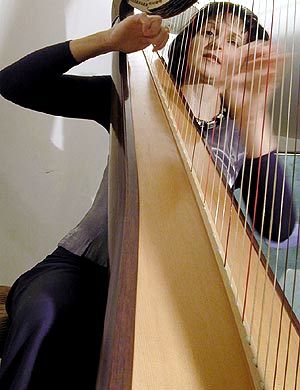The first of Suzanna Klintcharova’s trio of discs, La Belle Époque de la Harpe, is devoted exclusively to solo compositions for the harp by French composers, from the end of the 19th century through the first decades of the 20th. It is a twofold revelation to hear this intelligent artist at work, and to encounter the wealth of delights this specific repertoire offers.
The selections presented in this compilation cover a variety of compositional styles, chosen from a relatively short historical period. In them one can almost trace the development of both French music and of harp technique in this era. The Gallic fascination with Spanish rhythm, the use of ancient modes, and an adherence to triple meter are woven throughout these diverse works.
Ms. Klintcharova chose two giants of French music, Gabriel Fauré and Camille Saint-Saëns, to initiate this collection. Fauré’s voice is endearingly familiar, yet what makes his Impromptu, Op. 86, distinctive are the extreme contrasts in his writing. He exploits the full range of the instrument, ventures slightly off- center harmonically, and alternates between passages of great elegance and ones of stark drama. By comparison, Saint-Saëns’s Fantasie, Op. 95, is attractive, but tamer in overall scope. He was a gifted melodist, and in this piece there is a potpourri of beautiful tunes, from salon waltzes to troubadour chansons. Ms. Klintcharova’s keen attention to voicing and articulation are a great asset in both works. To round out the first part of this set, the harpist offers a charming interpretation of Gabriel Pierné’s Impromptu Caprice, Op. 9 ter, complete with musicalized birdcalls and a snappy bolero. This would make a terrific recital encore – neat and accessible with a strong bravura finish.
With Albert Roussel’s Impromptu, Op. 21, written for the great harpist Lily Laskine, the artist takes us further along the path into modernist territory. Roussel’s language is more dissonant and rhythmically driven, yet still maintains the hallmarks of French writing – modal melodies, Impressionistic harmonies, feathery glissandi. Again, the harpist’s pristine technique and infallible sense of time are well suited to Roussel’s writing. André Caplet’s Deux Divertissements, one in the French style and one in Spanish, reinforce my impression that Caplet is an underrated composer. Based on this performance, and the one of his Conte Fantastique in the second CD of this set, Ms. Klintcharova is making a great case for his renewed popularity. Caplet’s eccentric subtitles (i.e. ”with a graceful curve and well draped”) are worthy of Erik Satie. His coloristic effects, including mordant metallic chords and an impressively accurate imitation of guitar strumming, are rendered perfectly by the harpist.
Ms. Klintcharova, as much an historian as an artist, scores a coup with the inclusion of Marcel Tournier’s less well-known Sonatine No. 2, Op. 45. Tournier, a prolific performer, composer and educator, expands upon the traditions of French harp writing with fascinating results. The Sonatine calls for a player with great facility and imagination, as it ranges from the most delicate, exotic dances, to full-blown Romanticism and exacting passagework. Ms. Klintcharova has the stamina and talent to pull all this off. It would be difficult to find a better introduction to the “Belle Époque” than the one provided here in this very satisfying recording. I look forward to hearing more of Suzanna Klintcharova’s work in future ventures.

